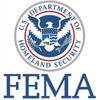Coastal Special Flood Hazard Area (SFHA) and Flood Zones
The procedures for mapping the coastal SFHA and the different zones within that area are very different than those used for rivers and small lakes. This is due to the changing influence of the various components of the coastal BFE. To account for these changes, transects are used to represent reaches of shoreline with similar physical and cultural characteristics.
Within the coastal SFHA, there are two primary zones: Zone AE and Zone VE. Each zone will have different base flood elevations (BFEs) that will be comprised of some or all of the components outlined below. Changes in zone or BFE are shown on the FIRM as solid white lines, and are referred to as gutters.
Coastal AE Zones contain a wave height component, ranging from 0 to 3 feet in height. VE Zones have a wave component that is greater than 3 feet in height. It is important to note that recent post disaster assessments and wave tank research have shown that waves as small as 1.5 feet can cause significant structural damage. Since 2009, coastal studies have been mapping the limit of the 1.5-foot wave as an informational layer, referred to as the Limit of Moderate Wave Action (LiMWA).
Inland Limit of the SFHA
Unless storm induced erosion or wave runup is expected to occur, the inland limit of the SFHA will be that point where the surge elevation intersects existing ground elevations. This is typically the case for bays, estuaries, and other areas not directly exposed to a passing coastal storm. For open coasts where wave runup and storm-induced erosion have been considered, the inland limit of the SFHA will most likely fall landward of this interface. How far landward is determined by the location of the primary frontal dune, the amount of wave runup, and the expected amount of storm-induced erosion.
Inland Limit of the Coastal High Hazard Area (VE Zone)
Within the coastal SFHA, the most hazardous zone is known as the VE Zone. Consequently, within the VE Zone different floodplain management regulations apply and insurance rates are higher. BFEs within the VE Zone can vary; however, the inland limit of the VE Zone is determined by finding the most landward of the following three points:
- the point where a 3-foot wave height can occur, or
- the point where the eroded ground profile (or non-eroded profile, if applicable) is 3 feet below the computed wave runup elevation; and
- the inland limit of the primary frontal dune as defined in the NFIP regulations.
If water is expected to overtop a protective barrier (dune or man-made structure), an assessment of the amount of water overtopping that structure will be made. Depending on the results of that assessment, the VE Zone may be moved farther landward to account for energy dissipation.
Coastal Base (1% annual chance) Flood Elevations (BFEs)
Inland BFEs along rivers, streams, and small lakes contain only one component, which is a function of the amount of water expected to enter an area and the geometry of the floodplain. Coastal BFEs can contain many components, particularly because of the impact of waves.
Storm Surge Component of Coastal BFE
Storm surge is the main component of the coastal BFE. It is determined one of two ways: using mathematical models that simulate storms, or statistical analyses of historical lake level records. Storm surge elevations are often referred to as “stillwater elevations” because they do not include wave effects.
Wave Height Component of Coastal BFE
As waves pass a particular point, the water-surface elevation fluctuates. The magnitude of that fluctuation is a function of the wave height. To predict wave heights, FEMA typically uses the Wave Height Analysis for Flood Insurance Studies (WHAFIS) model, which is based on simplified assumptions about waves propagating over flooded lands. In particular, wave hazards are controlled by about the highest 1 percent of waves, which continually break so wave height is considered limited to a certain fraction of local water depth. The WHAFIS equations take into consideration water depth (mean water elevation minus ground elevation), wind speed, wave period, vegetative cover, building density, and the fetch length (distance across the water over which the wind blows). Of these variables, wave height is usually most influenced by water depth and fetch length.
Wave Runup
Wave runup is the vertical height above the surge elevation to which water will rush. It is a function of the roughness and geometry of the shoreline at that point where the surge elevation intersects the land. Generally, wave runup is considered only in areas where this interface is steep, such as at bluffs, large dunes, and man-made structures.






